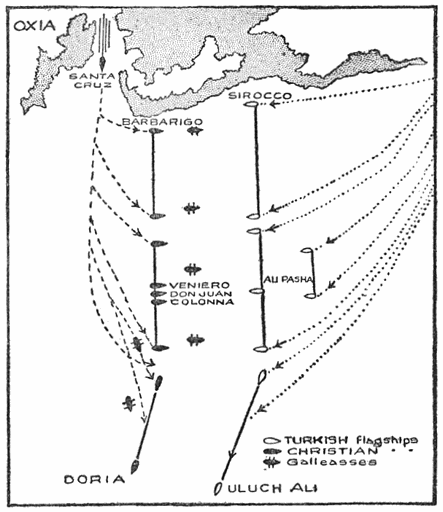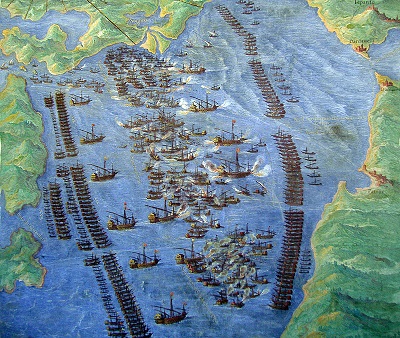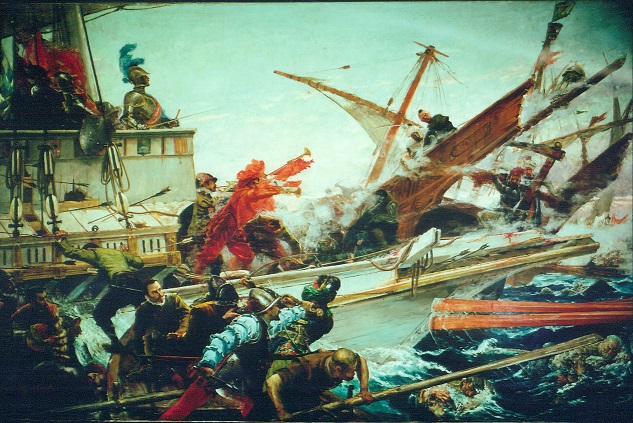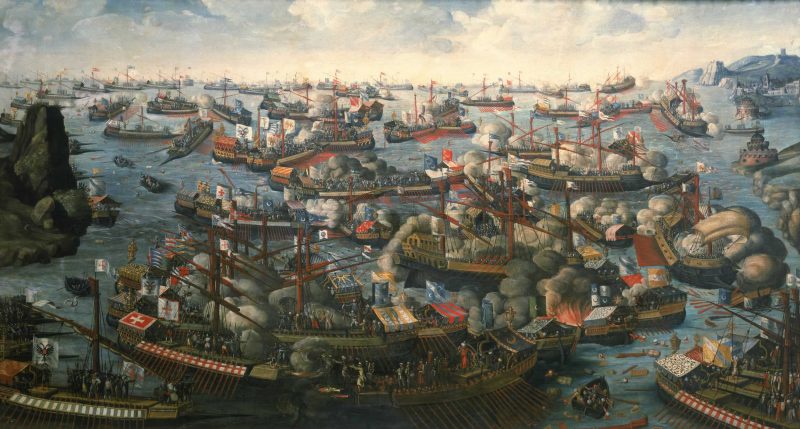The Siege of Venetian Famagusta, which lasted over a year and ended in Ottoman victory, was a critical loss for the Christian world. The merciless siege and subsequent horrific death of Marco Antonio Bragadin threw the entire Mediterranean into shock and hatred towards the viciousness of the Ottoman Empire.
Thus, on the 25th of May 1571, a league between the Catholic maritime states was arranged by Pope St. Pius V in order to deal with the Ottomans’ control over the Mediterranean. The Holy League’s members were the Papal States, Habsburg, Sicily, Naples, the republics of Venice and Genoa, and the duchies of Savoy, Parma, Urbino, and Tuscany. The Holy League also included the famous Knights Hospitallers of Malta.
The Holy League’s force was under the supreme command of Don Juan de Austria, who was the illegitimate son of the Holy Roman Emperor Charles V, and the brother of King Philip II of Spain.
Forces and Deployment

On the 7th of October, 1571, the fleet of the Holy League encountered the Ottoman forces near the Gulf of Patras in the Ionian sea. The commanders of the Ottoman navy were expressly commanded to attack any enemy they encountered. Their forces numbered about 251 ships (galleys and galliots), 31,000 soldiers, 50,000 sailors and oarsmen, and 750 guns.
It was in the Holy League’s best interest to quickly and successfully finish the campaign against the Ottoman fleet, before internal conflict could weaken the League. Commander Don Juan’s navy was formidable. The members of the league had gathered 212 ships (six 44-gun galleasses and 206 galleys), 28,000 soldiers, 40,000 sailors and oarsmen, and 1,815 guns.
In terms of force, the allies had a significant advantage, since they vastly outnumbered the Ottomans in guns and cannons. Furthermore, the discipline and force of the Spanish infantry was far more superior to that of the enemy. The Ottomans, although great in manpower, were in a bad position, due to the fact a larger part of their soldiers were slaves whose loyalty and morale were somewhat questionable.
Before the initial naval battle, the League deployed their ships in four divisions, forming a line from north to south. A central division was under the supreme commander himself, together with chief admiral Sebastiano Venier, commander Mathurin Romegas of the Knights Hospitallers, and admiral Marcantonio Colonna. The Venetian, Agostino Barbarigo was assigned to control the left, while Admiral Giovanni Andrea Doria took over the right division. A central reserve was formed by the Spaniard Álvaro de Bazán, but could not make it in time for the battle.
The Ottoman fleet, which was just across the bay, also used a similar formation. The commander, Ali Pasha, took command of the center, while Mohammed Saulak, who was the governor of Alexandria, was assigned to take the right division of the Ottoman navy. The left was under Uluch Ali, who was the pasha of Algiers.
The Battle

At the very opening of the battle, the Holy League successfully sank two of the Ottoman galleys and broke their formation. The Ottoman fleet sailed towards the allies, and the ships of Uluc Ali tried to outflank those of Andrea Doria’s right division and separated them from the center under Don Juan. Fire opened between that two enemy division; Uluc Ali’s part of the fleet was dueling with Doria’s.
Mahomet Saulak attacked the left flank of the league’s fleet but was repelled by the galleys who had not managed to reach their deployment place before the battle started. The Venetians under Agostino Barbarigo fought bravely and with the help of the reserve began overwhelming the Ottoman right.
The battle’s hardest clash was between the two flagships, which met shortly after the battle began. The Real of Don Juan de Austria was in a desperate struggle for victory over the Sultana of Ali Pasha.
The troops of the Spanish galley restlessly tried to take over and board the enemy’s ships. They were twice repulsed by the Ottomans until the reserve under Álvaro de Bazán came to the aid. With the help of the galleys of Bazan, they were able to turn the tide in their favor and take the Sultana of Ali Pasha.

Ali Pasha’s head was severed from his body and displayed on a pike for all to see. This had a huge impact on the Ottoman forces. Seeing the head of their commander on the pike significantly lowered their morale and they began to withdraw from the battle. Uluc Ali, who had succeeded against the Maltese division of Doria and captured his flagship, the Capitana, also chose to retreat with what was left of his ships. This was the only prize the Ottomans managed to keep.
At 4 PM, the battle was over. The Ottomans lost almost all their ships. 1307 of them were captured, and 50 sunk, while the 20 of the Holy League ships were sunk and 30 others suffered irreparable damage. The victory’s cost was about 7,500 lives, yet the allies freed 12,000 captured Christians, forced to serve in the Ottoman’s navy. 20,000 dead, wounded or captured was the blood price the Ottoman army paid for their defeat.
The victory in the Battle of Lepanto in 1571 , which was part of the Ottoman- Venetian War, is of great significance for history, effectively ending Ottoman expansion. The Ottoman navy managed to quickly regain their forces in order to continue their quest, but a treaty on the 7th of March 1573 put an end to the war. Venice was forced to pay tribute to the Ottoman Empire of Selim II and give up control over Cyprus. Peace was maintained until the Cretan war.
